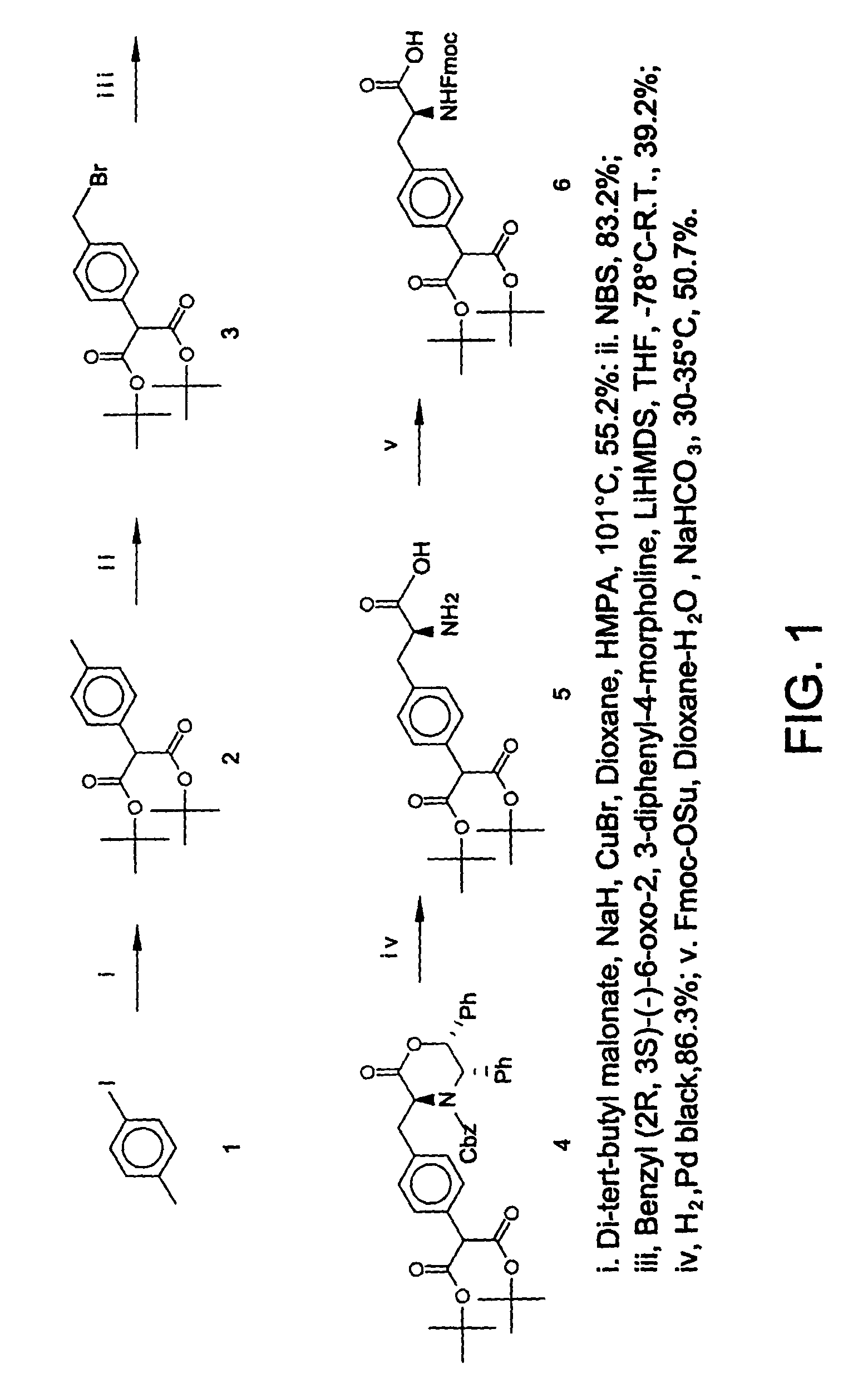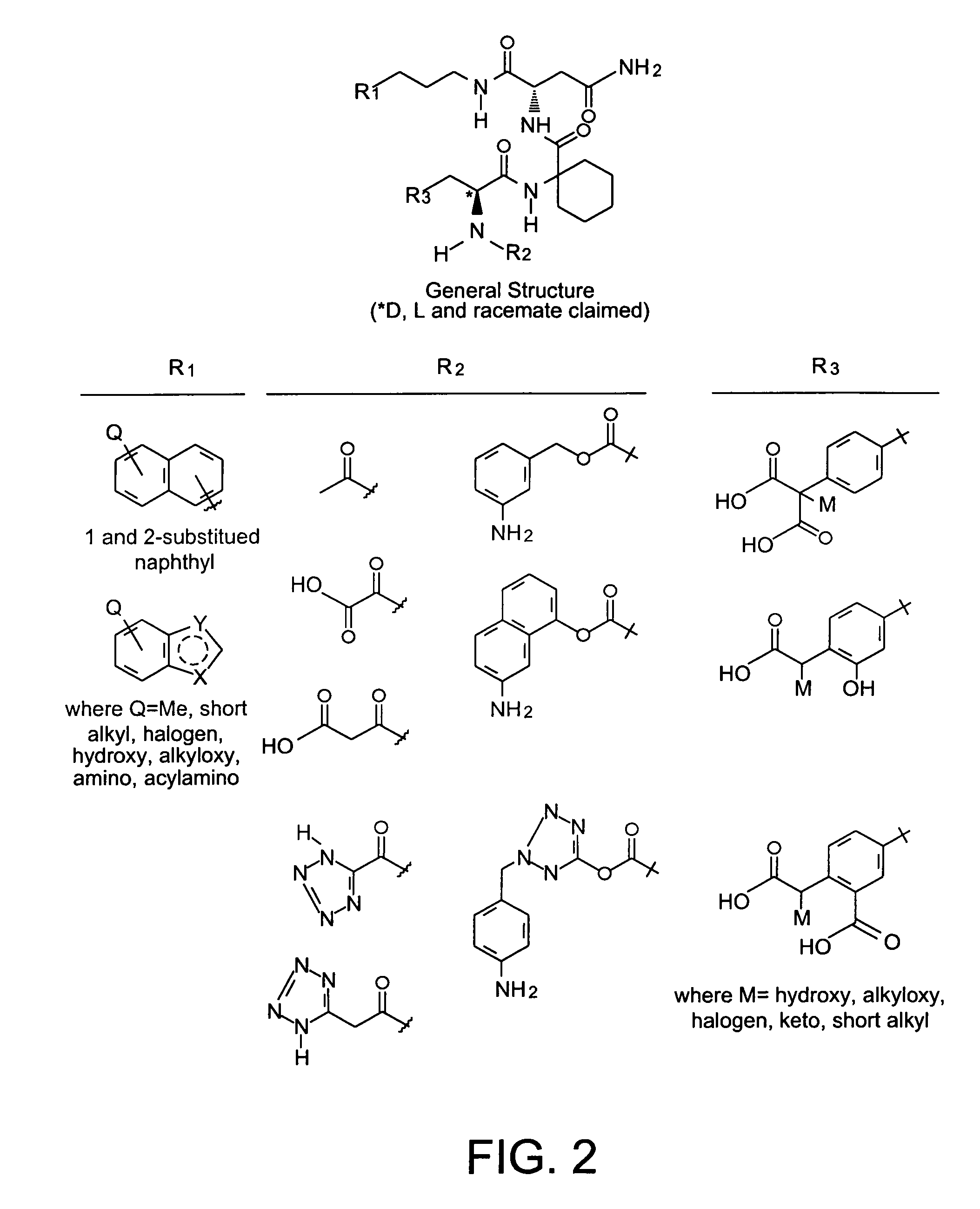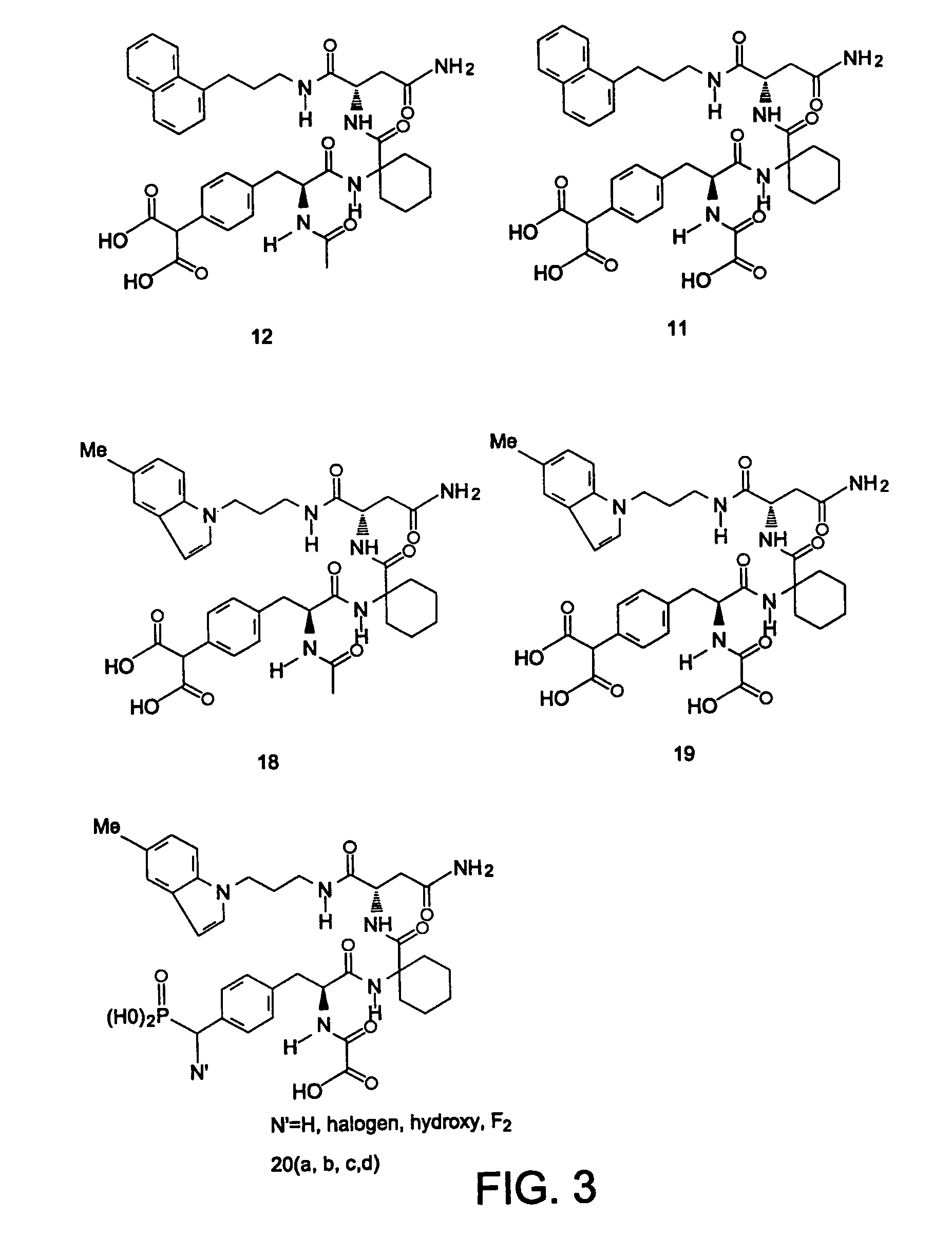Phenylalanine derivatives
a technology of phenylalanine and derivatives, applied in the field of phenylalanine derivatives, compositions, can solve the problems of inability to adapt to in vivo application of inhibitors, inability to achieve high affinity binding, etc., to achieve the effect of enhancing the therapeutic effect of a treatmen
- Summary
- Abstract
- Description
- Claims
- Application Information
AI Technical Summary
Benefits of technology
Problems solved by technology
Method used
Image
Examples
example 1
[0133]This Example illustrates a method of preparing and characterizing certain compounds of formula I. The synthetic procedure is schematically illustrated in FIG. 1.
[0134]p-Tolyl-malonic acid di-tert-butyl ester (2). To the suspension of sodium hydride (60%, 1.2 g, 30 mmol) in 50 ml of anhydrous dioxane containing 3.5 ml of HMPA were added di-tert-butyl malonate (6.488 g, 30 mmol) and p-iodotoluene (1), the mixture was stirred at room temperature for 1 hour. To the resulting solution was added copper (I) bromide (5.163 g, 36 mmol, 1.2 equivalents), the mixture was heated at refluxing temperature. Then the reaction mixture was cooled to room temperature, 30 ml of saturated aqueous ammonium chloride solution was added to quench the reaction, and the product was extracted with ethyl acetate (50 ml×3), washed with brine, dried over sodium sulfate. The solvent was evaporated, and the oily residue obtained was purified by chromatography to give p-tolyl-malonic acid di-tert-butyl ester 5...
example 2
[0139]This Example illustrates a method of preparing embodiments of formula X. The reactions are schematically depicted in FIGS. 4–14.
[0140]Compound 8. To the solution of compound 7 (45.5 mg, 0.1 mmol) in anhydrous DMF (2 ml) was added an active ester solution formed by reacting N-Fmoc-4-(di-tert-butoxycarbonyl-methyl)-L-phenylalanine (60.1 mg, 0.1 mmol), HOBt, H2O (13.5 mg, 0.1 mmol) and DIPCDI (15.6 μl, 0.1 mmol) in anhydrous DMF (2 ml) at room temperature (10 min.). The reaction mixture was then stirred at room temperature overnight. The solvent was removed under high vacuum and the residue obtained was purified by silica gel chromatography (CHCl3-EtoAc-MeOH mixture) to provide the desired product, compound 8, as a white foam (100% yield). 1H NMR (CDCl3) δ: 8.01 (2H, m), 7.81˜7.71 (6H, m), 7.50˜6.95 (12H, m), 6.58 (1H, s), 5.56 (3H, m), 4.69 (1H, m), 4.55˜4.40 (1H, m), 4.40 (1H, s) 4.31 (2H, d, J=6.84 Hz), 4.09 (1H), m), 3.34 (1H, m), 3.12˜2.88 (5 H, m), 2.63 (1H, dd, J=4.4, 15.1...
example 3
[0151]This Example illustrates a method of preparing some compounds of formula I. The reaction involved are schematically illustrated in FIG. 14.
[0152]2-Carboxymethyl-5-methyl-benzoic acid was prepared according to the published methods (J. Org. Chem., 4689 (1962)).
[0153]2-Tert-butoxycarbonylmethyl-5-methyl benzoic acid tert-butyl ester (21). To a suspension of 2-carboxymethyl-5-methyl-benzoic acid (2.544 g, 13.1 mmol) in anhydrous dichloromethane (70 ml) held at 0° C. was added tert-butyl 2,2,2-trichloroacetimidate (11.47 mg, 52.4 mmol, 2 equivalents) in cyclohexane (85 ml). BBr3 (0.52 ml) was then added, and the reaction mixture was raised to room temperature and stirred for 16 hr. Solid NaHCO3 was added to quench the reaction, the solid precipitate was filtered off and washed with ether. The combined organic washing was evaporated to dryness, and the residue obtained was purified by silica gel chromatography to obtain 2-tert-butoxycarbonylmethyl-5-methyl benzoic acid tert-butyl e...
PUM
| Property | Measurement | Unit |
|---|---|---|
| temperature | aaaaa | aaaaa |
| temperature | aaaaa | aaaaa |
| temperature | aaaaa | aaaaa |
Abstract
Description
Claims
Application Information
 Login to View More
Login to View More - R&D
- Intellectual Property
- Life Sciences
- Materials
- Tech Scout
- Unparalleled Data Quality
- Higher Quality Content
- 60% Fewer Hallucinations
Browse by: Latest US Patents, China's latest patents, Technical Efficacy Thesaurus, Application Domain, Technology Topic, Popular Technical Reports.
© 2025 PatSnap. All rights reserved.Legal|Privacy policy|Modern Slavery Act Transparency Statement|Sitemap|About US| Contact US: help@patsnap.com



